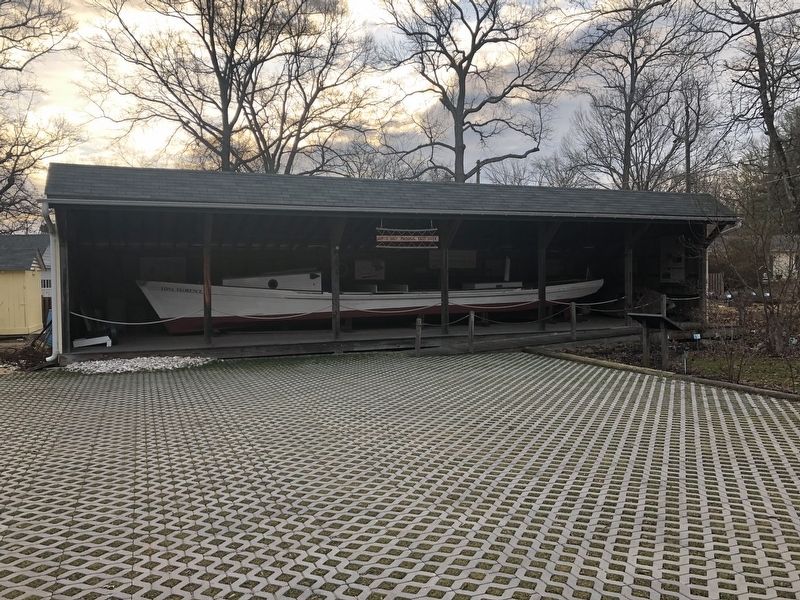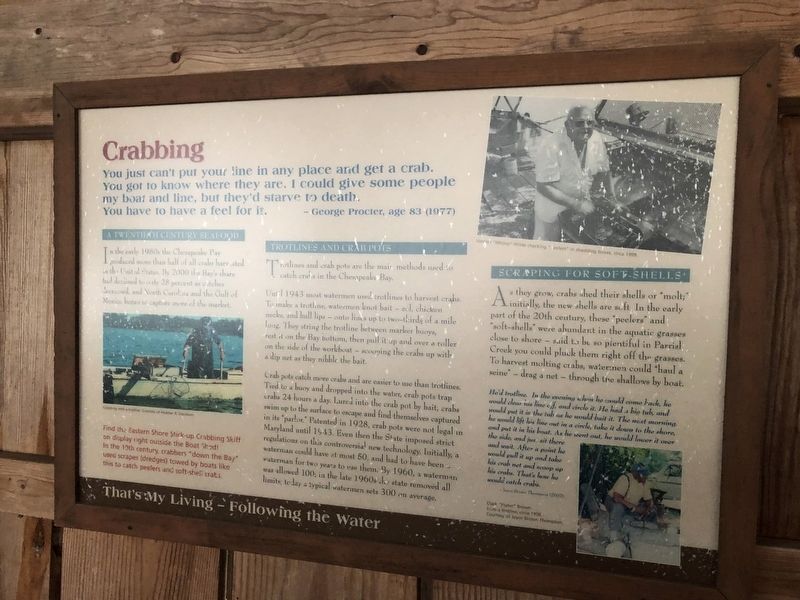Shady Side in Anne Arundel County, Maryland — The American Northeast (Mid-Atlantic)
Crabbing
— George Procter, age 83 (1977)
A Twentieth Century Seafood
In the early 1980s the Chesapeake Bay produced more than half of all crabs harvested in the United States. By 2000 the Bay's share had declined to only 28 percent as catches decreased, and North Carolina and the Gulf of Mexico began to capture more of the market.
[Caption] Find the Eastern Shore Stick-up Crabbing Skiff on display right outside the Boat Shed! In the 19th century, crabbers "down the Bay" used scrapes (dredges) towed by boats like this to catch peelers and soft-shell crabs.
Trotlines and Crab Pots
Trotlines and crab pots are the main methods used to catch crabs in the Chesapeake Bay.
Until 1943 most watermen used trotlines to harvest crabs. To make a trotline, watermen knot bait — eel, chicken necks, and bull lips — onto lines up to two-thirds of a mile long. They string the trotline between marker buoys, rest it on the Bay bottom, then pull it up and over a roller on the side of the workboat — scooping the crabs up with a dip net as they nibble the bait.
Crab pots catch more crabs and are easier to use than trotlines. Tied to a buoy and dropped into the water, crab pots trap crabs 24 hours a day. Lured into the crab pot by bait, crabs swim up to the surface to escape and find themselves captured in its "parlor." Patented in 1928, crab pots were not legal in Maryland until 1943. Even then the State imposed strict regulations on this controversial new technology. Initially a waterman could have at most 50, and then had to have been a waterman for two years to use them. By 1960, a waterman was allowed 100; in the late 1960s the state removed all limits; today a typical watermen sets 300 on average.
Scraping for Soft-Shells
As they grow, crabs shed their shells or "molt;" initially, the new shells are soft. In the early part of the 20th century, these "peelers" and "soft-shells" were abundant in the aquatic grasses close to the shore — said to be so plentiful in Parrish Creek you could pluck them right off the grasses. To harvest molting crabs, watermen could "haul a seine" — drag a net — through the shallows by boat.
He'd trotline. In the evening when he would come back, he would clear his line off, and circle it. He had a big tub, and would put it in the tub as he would bait it. The next morning, he would lift his line out in a circle, take it

Photographed By Devry Becker Jones (CC0), February 16, 2019
2. The marker is part of this outdoor exhibit.
— Joyce Brown Thompson (2002)
[Caption]
Clark "Flutes" Brown baits a troutline, circa 1990.
Courtesy of Joyce Brown Thompson.
That's My Living — Following the Water
Erected by Chesapeake Bay Gateways Network.
Topics. This historical marker is listed in these topic lists: African Americans • Industry & Commerce • Waterways & Vessels. A significant historical year for this entry is 2000.
Location. 38° 50.955′ N, 76° 30.711′ W. Marker is in Shady Side, Maryland, in Anne Arundel County. Marker is on East West Shady Side Road west of Bast Avenue, on the right when traveling north. Touch for map. Marker is at or near this postal address: 1418 East West Shady Side Road, Shady Side MD 20764, United States of America. Touch for directions.
Other nearby markers. At least 8 other markers are within walking distance of this marker. Fishing (here, next to this marker); Seasons of the Waterman (here, next to this marker); Eels, Ducks, and Clams (here, next to this marker); The Edna Florence (a few steps from this marker); Oystering (a few steps from this marker); Transformation of the Avery House and over a Century of Expansion (a few steps from this marker); Going to Market (a few steps from this marker); Edna Florence (a few steps from this marker). Touch for a list and map of all markers in Shady Side.
Credits. This page was last revised on March 18, 2019. It was originally submitted on February 16, 2019, by Devry Becker Jones of Washington, District of Columbia. This page has been viewed 241 times since then and 16 times this year. Photos: 1, 2. submitted on February 16, 2019, by Devry Becker Jones of Washington, District of Columbia. • Bill Pfingsten was the editor who published this page.
